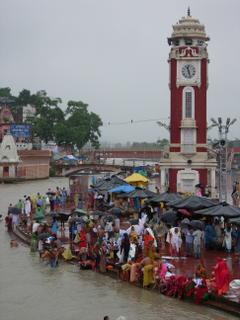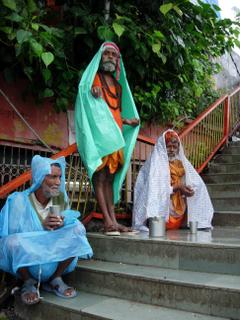 like thousands of hindu pilgrims before us, haridwar drew cole and i to the sacred site where the ganges leaves the mountains. with a vague idea of how we were getting to haridwar, we left king’s chambers in the rainy darkness at 6 am and met our taxi. on the road, we happened upon the bus to haridwar. our taxi driver signaled the bus and pulled over, and we hoped that the curly hindi letters said, “haridwar” and not some faraway land. cole and i packed ourselves into the seat, marveling at the apparent size of indian people’s butts. the 90 cent ride took us the hour-an-a-half on the bumpy road with the bus attendant shouting, “haridwar-haridwar-haridwar,” out the window at passing pedestrians. we arrived at the haridwar bus station during a torrential downpour. our rickshaw driver gave cole and i an umbrella to keep us dry as he pedaled us to our hotel in the bazaar. the seat of the rickshaw was so narrow that cole and i felt almost as if we were going to fall out into the lanes of buses, cars, mopeds and bicycles—another indication that indians must enjoy food less than said foreigners.
like thousands of hindu pilgrims before us, haridwar drew cole and i to the sacred site where the ganges leaves the mountains. with a vague idea of how we were getting to haridwar, we left king’s chambers in the rainy darkness at 6 am and met our taxi. on the road, we happened upon the bus to haridwar. our taxi driver signaled the bus and pulled over, and we hoped that the curly hindi letters said, “haridwar” and not some faraway land. cole and i packed ourselves into the seat, marveling at the apparent size of indian people’s butts. the 90 cent ride took us the hour-an-a-half on the bumpy road with the bus attendant shouting, “haridwar-haridwar-haridwar,” out the window at passing pedestrians. we arrived at the haridwar bus station during a torrential downpour. our rickshaw driver gave cole and i an umbrella to keep us dry as he pedaled us to our hotel in the bazaar. the seat of the rickshaw was so narrow that cole and i felt almost as if we were going to fall out into the lanes of buses, cars, mopeds and bicycles—another indication that indians must enjoy food less than said foreigners.in the midst of the rain, we made our way to har-ki-pairi (the footstep of god where vish
 nus allegedly left his footprint) is the focus of pilgrimages. the power of the ganges to absolve sins at har-ki-pairi is believed to be unmatched. i guess washing my hands in the river could pardon me from some of my worldly deeds, so i can consider the trip a success. people bathed in the freezing water, men on near the ghat and women across the bank. others deified the ganga by pouring milk or dropped flowers into the rushing waters. sadhus (those who have given up the worldly to pursuer a spiritual quest) populate the banks, some with their faces painted like clowns and their hair matted into a single, spiked dreadlock. one sadhu with skin painted entirely white lived under the mangled, exposed roots of a tree near the banks of the river. the rest of the river is lined by individuals from all castes—from families adorned in rich fabrics to beggars huddled under sheaths of plastic, seeking refuge from the rain. because many who make the trip to the banks of the ganges are sadhus or impoverished devotees, men mill around the river and take donations to provide for the pilgrims. queues of people gather outside of restaurants on the river to collect food in bowls made of leaves.
nus allegedly left his footprint) is the focus of pilgrimages. the power of the ganges to absolve sins at har-ki-pairi is believed to be unmatched. i guess washing my hands in the river could pardon me from some of my worldly deeds, so i can consider the trip a success. people bathed in the freezing water, men on near the ghat and women across the bank. others deified the ganga by pouring milk or dropped flowers into the rushing waters. sadhus (those who have given up the worldly to pursuer a spiritual quest) populate the banks, some with their faces painted like clowns and their hair matted into a single, spiked dreadlock. one sadhu with skin painted entirely white lived under the mangled, exposed roots of a tree near the banks of the river. the rest of the river is lined by individuals from all castes—from families adorned in rich fabrics to beggars huddled under sheaths of plastic, seeking refuge from the rain. because many who make the trip to the banks of the ganges are sadhus or impoverished devotees, men mill around the river and take donations to provide for the pilgrims. queues of people gather outside of restaurants on the river to collect food in bowls made of leaves.following our trip to the ghat, we walked up about 1 km of stairs to the mansa devi temple. we tried to protect our prasad (donations to the goddess) from the monkeys eagerly watching people climbing the steps. we luckily met a kind indian family from britain who guided us through the temple, which seemed more an exercise in queuing and donating money than a religious experience. following our "religious" experience, i went into the bazaar to purchase fabric for a salwarcami, a long shirt worn by women that is sometimes accompanied by a shawl or matching pants. the shopowner eagerly threw fabric onto my lap, removing nearly 50 packages of cloth from the shelves. the shopping trip was almost akin to browsing in a store where the salespeople work based solely on commission.
 at dusk the ghat is illuminated by the ganga aarti (the river worship ceremony) performed by priests. as we made our way to the river for the ceremony, we met with a parade, complete with a statue of ganesh (the elephant-headed god) and men playing brass instruments to celebrate ganesh’s birthday. i have a certain affinity for ganesh, so i will write more about him later. we arrived at the river and took a place amongst the other pilgrims and next to a small boy who loved speaking english with us. a small girl navigated through the crowd, placing bindis on peoples' heads and then charging a small fee for her work. that's really the main idea in india and in the hindu ceremonies we attended, give without asking and then charge a fee. as it grew darker, the security guards dispersed in the crowd, yelling instructions, orders, god-knows-what, in hindi. when the ceremony started, the priests outside of the ghat lit up the night sky with their torches. singing and chanting poured out of the loudspeakers, and cole and i clapped along with the crowd. sometimes people threw their hands in the air, crying out in hindi, so cole and i obliged as well. it's funny feeling a kinship with the people around you when you are sharing in an experience you don't completely understand. people placed small vessels constructed of leaves and flowers and lit by a small candle into the river, praying as the boat flowed downstream.
at dusk the ghat is illuminated by the ganga aarti (the river worship ceremony) performed by priests. as we made our way to the river for the ceremony, we met with a parade, complete with a statue of ganesh (the elephant-headed god) and men playing brass instruments to celebrate ganesh’s birthday. i have a certain affinity for ganesh, so i will write more about him later. we arrived at the river and took a place amongst the other pilgrims and next to a small boy who loved speaking english with us. a small girl navigated through the crowd, placing bindis on peoples' heads and then charging a small fee for her work. that's really the main idea in india and in the hindu ceremonies we attended, give without asking and then charge a fee. as it grew darker, the security guards dispersed in the crowd, yelling instructions, orders, god-knows-what, in hindi. when the ceremony started, the priests outside of the ghat lit up the night sky with their torches. singing and chanting poured out of the loudspeakers, and cole and i clapped along with the crowd. sometimes people threw their hands in the air, crying out in hindi, so cole and i obliged as well. it's funny feeling a kinship with the people around you when you are sharing in an experience you don't completely understand. people placed small vessels constructed of leaves and flowers and lit by a small candle into the river, praying as the boat flowed downstream.
we departed for our journey home and reaffirmed the notion that in india, much of the adventure is in the transit. notably, our second bus was delayed from departing the dehra dun station because a baby boy was relieving himself on the sidewalk alongside the bus. what’s not to love about india?








1 comment:
Wow, watch where you point that Bell Hooks quote. It's loaded. Heady stuff. A joy to read and the photographs are spectacular.
Post a Comment